Paradigm Shifters and the New Planet, Eris
by Henry Seltzer
Originally published in The Mountain Astrologer, 2015
We are the music-makers,
And we are the dreamers of dreams,
Wandering by lone sea-breakers,
And sitting by desolate streams;
World-losers and world-forsakers,
On whom the pale moon gleams:
Yet we are the movers and shakers
Of the world forever, it seems.
— Arthur O’Shaughnessy
In this article, we will be taking an astrological look at those individuals who have gone against the grain of established science or culture in order to develop their own unique viewpoint and, in so doing, created a new way of seeing the world around them. I am speaking most specifically of those individuals throughout the history of science who were instrumental in bringing about what is now known as a “paradigm shift” by changing the rules of the game — the pre-existing “laws” of nature. By creating something rich and strange, these intrepid souls were fated to establish a new viewpoint that then became the next established paradigm.
As Albert Einstein put it,
To punish me for my contempt for authority, fate made me an authority myself.1
There have been many such people, with perhaps the most iconic example in our own era represented by the work of Einstein. In the opening years of the 20th century, he stood existing physics on its head with his theory of relativity, among other mathematical rearrangements of our understanding of the way that the physical universe works. In speaking about Einstein and other examples of paradigm shifters, we will also discuss a fresh astrological archetype that is currently emerging in the zeitgeist of this new century: the recently named planet, Eris.
It is a startling idea, but there is a new outer-planet archetype out there, more or less in plain sight. I am referring of course to Eris, which was named a “dwarf planet” in 2006, when the International Astronomical Union (IAU) also downgraded Pluto to this same category. Many in the astrological community have therefore felt that Eris is just another sort of asteroid, or minor planet, like the thousands already existing in the asteroid belt — maybe a special one, such as the major feminine asteroids Ceres, Pallas, Juno, and Vesta, but in no way as fundamental in charts as the well-known and extremely powerful outer-planet archetypes of Uranus, Neptune, and Pluto.
I have taken a different approach, de-emphasizing in this designation the word “dwarf” and focusing on the word “planet.” I have been inspired to investigate Eris as a potentially significant Western archetype, perhaps every bit as powerful as the existing outer-planet archetypes that have come to us from the astronomical discoveries of the previous three centuries.
My starting point with Eris was this: Pluto remains an incredibly important Western archetype, and Eris is Pluto’s twin. Although about the same diameter, Eris is far more dense. Other than this distinction, Eris is essentially identical to Pluto in size, category, and position in the solar system, being located within the Kuiper Belt, beyond the orbit of Neptune. It remains to be seen whether the other early “dwarf” planets of this region, Makemake and Haumea, will also prove to be important in charts. I suspect so.
Because Eris is identical to Pluto in astronomical category, I reasoned that it could be just as powerful in charts. Somewhat to my surprise, my research has confirmed this rather radical statement. I will share some of my discoveries regarding Eris in this article; it will give you a taste of my new book (due out in Spring from The Wessex Astrologer) entitled The Tenth Planet: Revelations from the Astrological Eris. In the book, I develop the idea that Eris represents a feminine or a spiritual warrior energy, which is consistent with the mythology of Eris — the sister of Ares, the Greek God of War — who willingly followed him into the battle and delighted in the groans of the dying, according to descriptions from ancient myth. While the meaning of Eris in charts also seems to represent a feminine warrior energy, this astrological archetype includes a depth component similar to that of Pluto, which is quite distinct from the mythological Eris, as is often the case.
The research I have conducted for several years confirms that individuals with a strong Eris will fight for what they believe in and that they must follow their own inner compass in so doing. Their mission comes from deep inside them and could be equated with what I have been calling “soul purpose” — that which, once you are aware of it, you cannot refrain from doing. My thesis is that everyone has such a sense of purpose and that one priority of life is to discover it. This is related to the Hindu concept of dharma, the set of tasks you came into this lifetime to fulfill. Eris, like Pluto, refers to the depths of the psyche, to areas within us that are relatively unconscious.
One way of looking at life is that our mission is to make the unconscious areas of our psyche more available to our conscious understanding. Then, too, we all might need to heed the oft-repeated injunction from historian of myth Joseph Campbell, to “follow your bliss,” to find within ourselves our own unique hidden talent that we were born to develop. This is why the emergence of this key archetypal energy is so vital and alive for us now.
Of course, rather than take my word for this, I encourage you to find out where Eris is in your own chart and in the charts of others around you, and begin to do this exciting research for yourself. As I started this work, I looked at the charts of two dozen or more feminist figures from the history of the modern movement, dating back to the 18th century, and I found that, without exception, they all had a strong Eris. That makes sense in view of this characterization that I espouse, of Eris as spiritual warrior for soul purpose, because the issue of equal rights was vitally important to these feminist leaders. They could not but do, at all costs, what they felt to be in full accordance with what came to them from the very depths of their being.
In light of facts such as these, I theorized that I would likely find strong Eris contacts in the natal charts of paradigm shifters as well — those courageous souls who have almost single-handedly changed the course of scientific history. That theory was confirmed when I began examining the charts of these brave and contrary individuals. Thus, one way to see this new planetary archetype quite objectively is to take a look at these people’s charts.
This process of the shifting of paradigms was described in the work of the great historian of science, Thomas S. Kuhn, who shook up existing ideas about scientific progress with the 1962 publication of The Structure of Scientific Revolutions. There, he elucidated his concept of scientific paradigm, the perceptual constraints through which the scientist sees his world around him, and also the paradigm shifts that happen when the observable exceptions to existing “laws” of science become sufficiently difficult to account for, so that a new explanatory model must be created. Kuhn’s classic example is the Copernican revolution in astronomy, when the many epicycles upon epicycles required to maintain the Ptolemaic Earth-centered system had become increasingly complex with greater observational accuracy, and finally gave way to the conceptual simplicity of the heliocentric model. Of course, this change in thinking did not come easily. It took dedicated individuals to promote the non-intuitive idea that the Earth, rather than being fixed, was actually moving through space in orbit around the Sun.
Copernicus, Galileo, Kepler, Newton
 As nearly everyone now knows, Nicolaus Copernicus was the
first modern astronomer to propose the heliocentric view of the solar
system. He circulated the information privately for most of his later
life, and published only when he was on his deathbed in 1543. It remained
for others to advance this theory against the strenuous objections of the
established powers of the 16th and 17th centuries, most notably the
Church. Key players who followed him were better able to provide proof of
the actual motions of the planets: Johannes Kepler by mathematics and
Galileo Galilei by direct observation, since he invented the telescope
some six decades after Copernicus’s death. Finally, in 1684, Isaac
Newton was able to show how the mathematics first brought forward by
Kepler could explain planetary motion, using the famous inverse square
law for the attraction of masses to one another that became known as the
“Law of Gravity.”
As nearly everyone now knows, Nicolaus Copernicus was the
first modern astronomer to propose the heliocentric view of the solar
system. He circulated the information privately for most of his later
life, and published only when he was on his deathbed in 1543. It remained
for others to advance this theory against the strenuous objections of the
established powers of the 16th and 17th centuries, most notably the
Church. Key players who followed him were better able to provide proof of
the actual motions of the planets: Johannes Kepler by mathematics and
Galileo Galilei by direct observation, since he invented the telescope
some six decades after Copernicus’s death. Finally, in 1684, Isaac
Newton was able to show how the mathematics first brought forward by
Kepler could explain planetary motion, using the famous inverse square
law for the attraction of masses to one another that became known as the
“Law of Gravity.”
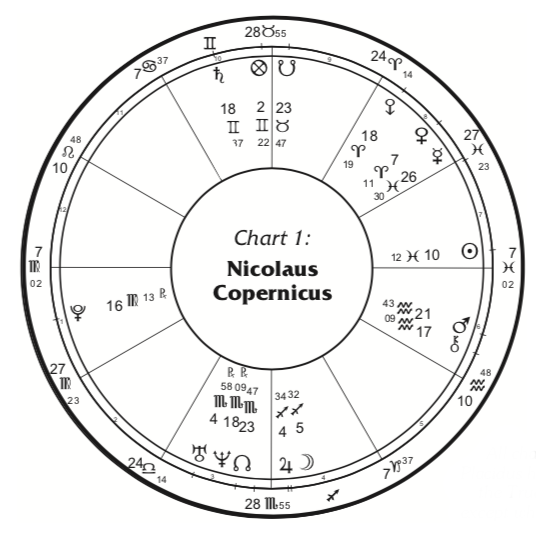 In the natal chart of Nicolaus Copernicus,
for which we have a reliable time of birth, Eris is found at 18° Aries,
the sign in which it is currently located; indeed, his birth is removed
from our own era by one full planetary period of Eris, or about 556
years. The sign boundaries have changed slightly, due to the precession
of the equinoxes, so that the recent years for this Eris position are the
1990s. Copernicus’s natal Eris makes close aspects to many of the
other planets in his chart, being sextile Mars; closely sextile both
Saturn and Chiron, residing near the midpoint of their trine;
sesquiquadrate his Jupiter–Moon conjunction; and also inconjunct
(quincunx) both Pluto and Neptune, making Eris the focal point of a yod.2
There is also a close contra-parallel between Eris and Mercury, his chart
ruler. All this adds up to an undeniably powerful position of natal
Eris.
In the natal chart of Nicolaus Copernicus,
for which we have a reliable time of birth, Eris is found at 18° Aries,
the sign in which it is currently located; indeed, his birth is removed
from our own era by one full planetary period of Eris, or about 556
years. The sign boundaries have changed slightly, due to the precession
of the equinoxes, so that the recent years for this Eris position are the
1990s. Copernicus’s natal Eris makes close aspects to many of the
other planets in his chart, being sextile Mars; closely sextile both
Saturn and Chiron, residing near the midpoint of their trine;
sesquiquadrate his Jupiter–Moon conjunction; and also inconjunct
(quincunx) both Pluto and Neptune, making Eris the focal point of a yod.2
There is also a close contra-parallel between Eris and Mercury, his chart
ruler. All this adds up to an undeniably powerful position of natal
Eris.
It is interesting that Copernicus’s partile Saturn–Neptune quincunx is a perfect chime for someone who would take a sacred approach to existing structures and dream new ones into being. He idealized the circle and felt that there was a spiritual as well as a mathematical truth to be revealed by the movement of the planets, including Earth, around the Sun in what he conceived as circular orbits.3 This aspect is greatly emphasized by the partile Eris connection to these two planets, with Saturn, Neptune, and Eris all at 18+ degrees of their respective signs. I have often found that the Eris connection to natal planets highlights these planets for the individual, in ways that correspond to deeper issues of the soul or the personality.
For Galileo and Kepler, born in the following century, Eris in Taurus in each case makes close aspects to their personal planets. Galileo (chart not shown) has Eris at the top of the chart and therefore emphasized. Eris makes a square to his probable Leo Ascendant and is closely sextile his Mercury–Pluto conjunction in Pisces, as well as conjunct his Moon and sextile his Pisces Sun. Eris also trines Chiron in Capricorn. Famously, Galileo suffered (Chiron) for his radical belief (Eris) in the heliocentric theory of the solar system. Having been declared a heretic by the Church for these beliefs, he was forced to recant and remained under house arrest for the rest of his life.
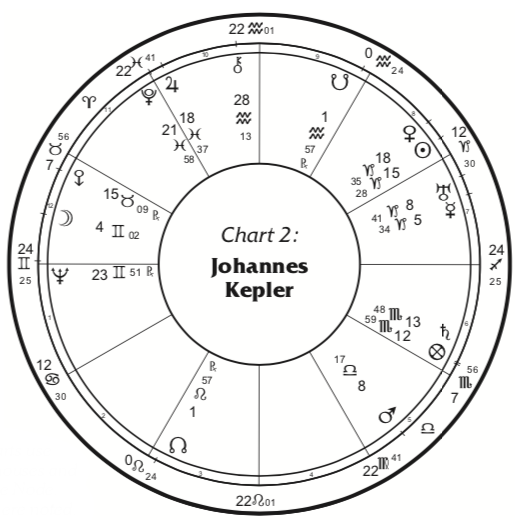 Kepler’s Eris, at the powerful 15°
mark of a fixed sign, makes a partile trine to his Sun and is also trine
Venus, bi-quintile (144°) Mars, in close opposition to Saturn, sextile
Jupiter, and trine Uranus. His Jupiter at 18° Pisces sextiles his
Sun–Venus conjunction and supports — by square and trine, respectively —
Copernicus’s partile Saturn–Neptune quincunx in Gemini–Scorpio,
being at the same degree: 18. This is fascinating, considering that
Kepler became the closest subsequent link to the heliocentric model,
until Newton’s work was made known nearly eight decades after
Kepler’s work was published.
Kepler’s Eris, at the powerful 15°
mark of a fixed sign, makes a partile trine to his Sun and is also trine
Venus, bi-quintile (144°) Mars, in close opposition to Saturn, sextile
Jupiter, and trine Uranus. His Jupiter at 18° Pisces sextiles his
Sun–Venus conjunction and supports — by square and trine, respectively —
Copernicus’s partile Saturn–Neptune quincunx in Gemini–Scorpio,
being at the same degree: 18. This is fascinating, considering that
Kepler became the closest subsequent link to the heliocentric model,
until Newton’s work was made known nearly eight decades after
Kepler’s work was published.
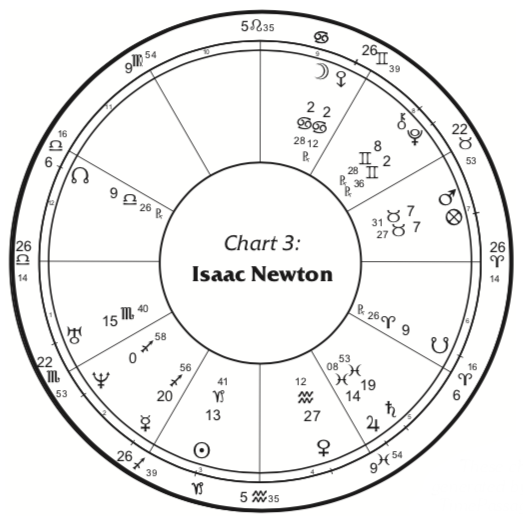 Newton’s chart also reveals a strong
Eris. As for the personal planets, Eris is elevated and partile conjunct
his Moon, widely opposed to the Sun, sextile Mars, and trine Venus (out
of sign). All three outer-planet archetypes are activated as well, since
Eris is sesquiquadrate Uranus, quincunx Neptune, and closely semi-sextile
Pluto. The combination of Eris with Pluto and with Uranus suggests a
revolutionary, and indeed in intellectual disciplines, Newton was this.
His work was radical at the time of its publication and eventually came
to define physics and mathematics for subsequent ages.
Newton’s chart also reveals a strong
Eris. As for the personal planets, Eris is elevated and partile conjunct
his Moon, widely opposed to the Sun, sextile Mars, and trine Venus (out
of sign). All three outer-planet archetypes are activated as well, since
Eris is sesquiquadrate Uranus, quincunx Neptune, and closely semi-sextile
Pluto. The combination of Eris with Pluto and with Uranus suggests a
revolutionary, and indeed in intellectual disciplines, Newton was this.
His work was radical at the time of its publication and eventually came
to define physics and mathematics for subsequent ages.
After his death, he was buried in Westminster Cathedral, with the following inscription:
Here is buried Isaac Newton, Knight, who by a strength of mind almost divine, and mathematical principles peculiarly his own, explored the course and figures of the planets, the paths of comets, the tides of the sea, the dissimilarities in rays of light, and, what no other scholar has previously imagined, the properties of the colours thus produced. Diligent, sagacious and faithful, in his expositions of nature, antiquity and the holy Scriptures, he vindicated by his philosophy the majesty of God mighty and good, and expressed the simplicity of the Gospel in his manners. Mortals rejoice that there has existed such and so great an ornament of the human race!
 It is interesting that transiting Eris was closely
involved at the initial publication of Newton’s discoveries
regarding planetary motion, validating the heliocentric model in support
of the work of Kepler and Copernicus. In late November 1684, Newton wrote
up and gave to his friend and colleague, Edmond Halley, his conclusions
about the motions of the planets and the inverse square formula for
gravitational attraction that accounted for Kepler’s elliptical
orbits. This nine-page paper, which was more formally published several
years later as part of Newton’s Principia Mathematica, was
called (in Latin) “On the Motion of Bodies in Orbit,” and was
placed into the records of the Royal Society on December 10, 1684
(Julian) or December 21, 1684 by the Gregorian calendar.
The transits for the Full Moon on the evening of this same date, actually
a lunar eclipse, (not shown) are dramatic. Remarkably, the eclipse
Moon is closely conjunct his Eris–Moon degree, with the Sun opposed.
Jupiter in Libra is in partile quincunx to Newton’s natal Saturn, and
transiting Uranus in Taurus closely sextiles his Eris–Moon conjunction in
early Cancer, while transiting Eris in partile conjunction with transiting
Saturn at 17° of Virgo makes an almost exact opposition to his natal
Saturn, which is conjunct Jupiter. Finally, Saturn and Jupiter, six
degrees apart in his 5th house, have their midpoint at precisely 17°
Pisces.
It is interesting that transiting Eris was closely
involved at the initial publication of Newton’s discoveries
regarding planetary motion, validating the heliocentric model in support
of the work of Kepler and Copernicus. In late November 1684, Newton wrote
up and gave to his friend and colleague, Edmond Halley, his conclusions
about the motions of the planets and the inverse square formula for
gravitational attraction that accounted for Kepler’s elliptical
orbits. This nine-page paper, which was more formally published several
years later as part of Newton’s Principia Mathematica, was
called (in Latin) “On the Motion of Bodies in Orbit,” and was
placed into the records of the Royal Society on December 10, 1684
(Julian) or December 21, 1684 by the Gregorian calendar.
The transits for the Full Moon on the evening of this same date, actually
a lunar eclipse, (not shown) are dramatic. Remarkably, the eclipse
Moon is closely conjunct his Eris–Moon degree, with the Sun opposed.
Jupiter in Libra is in partile quincunx to Newton’s natal Saturn, and
transiting Uranus in Taurus closely sextiles his Eris–Moon conjunction in
early Cancer, while transiting Eris in partile conjunction with transiting
Saturn at 17° of Virgo makes an almost exact opposition to his natal
Saturn, which is conjunct Jupiter. Finally, Saturn and Jupiter, six
degrees apart in his 5th house, have their midpoint at precisely 17°
Pisces.
The fact that Eris is so strong in Newton’s natal chart — coupled with these dramatic transits at the first publication of his theory of gravity, for which he is perhaps best known — reinforces the idea that Eris is indeed an archetypal match for these “world-shakers and world-forsakers” who change the course of human thought.
Other Paradigm Shifters
From more modern times, we see another paradigm shifter in Werner Heisenberg. This young German physicist articulated and helped to formulate the new quantum theoretical model of particle physics, which went beyond even Einstein in altering the way that we currently think about how the subatomic universe is put together.
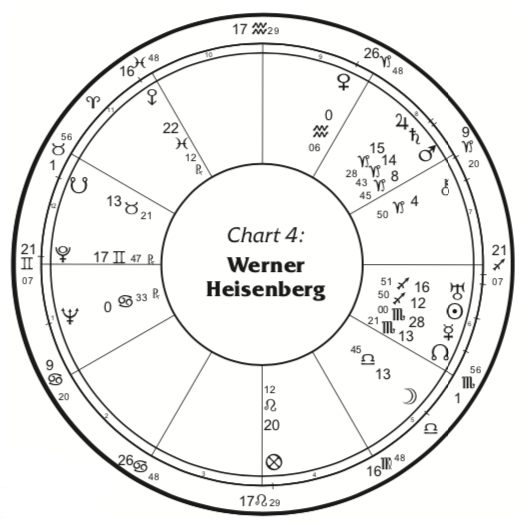 Heisenberg was born with Eris at 22°
Pisces widely square his Sun–Uranus conjunction in Sagittarius, trine
Mercury, septile (51°26^) Venus, and quintile (72°) Mars. Between June
and July of 1925, he formulated and, in September 1925, published an
important paper calling for a reinterpretation of the quantum theory. By
May 1, 1926, he had published his new mathematical equations. In 1927
came his famous “Uncertainty Principle.”
Heisenberg was born with Eris at 22°
Pisces widely square his Sun–Uranus conjunction in Sagittarius, trine
Mercury, septile (51°26^) Venus, and quintile (72°) Mars. Between June
and July of 1925, he formulated and, in September 1925, published an
important paper calling for a reinterpretation of the quantum theory. By
May 1, 1926, he had published his new mathematical equations. In 1927
came his famous “Uncertainty Principle.”
In late September 1925, when the first paper was published, Heisenberg’s natal Eris was transited by Uranus, while the Sun entering into Libra opposed the position of transiting Eris at 0° Aries. Transiting Eris thus made a partile square to his natal Neptune and a partile sextile to his Venus. Right in the middle of his time of inspiration, Eris was stationary, having stationed retrograde in 1925 on June 27. It is interesting to note that Neptune, transited by Eris in square, is the ruler of his 11th house of group participation. He was working in concert with several of his colleagues as he formulated the mathematics of quantum theory during this period, so some of the papers bear three names. Eris remained within one degree of 0° Aries through 1927, when it was also involved in a triple conjunction with transiting Jupiter and Uranus.4
The list of paradigm shifters could also include the previously mentioned science historian, Thomas S. Kuhn (chart not shown), who changed the way his field views paradigm shifts. Born on July 18, 1922, Kuhn has Eris at 0° Aries, conjunct the South Node and opposite Saturn in Libra within 2½ degrees. Natal Eris is trine his late Cancer Sun, quincunx Venus in Virgo, parallel Mars, square Mercury in Cancer, and in a tight sesquiquadrate to Neptune in Leo. His Eris thus pulls more closely together his natal Mercury–Saturn square, a very good thing for a historian. In 1962, when his landmark book, The Structure of Scientific Revolutions, was published, transiting Eris was at 9°–10° Aries, squaring natal Pluto in Cancer, opposing natal Jupiter in Libra, and trining natal Mars in Sagittarius — all exact or within one degree.
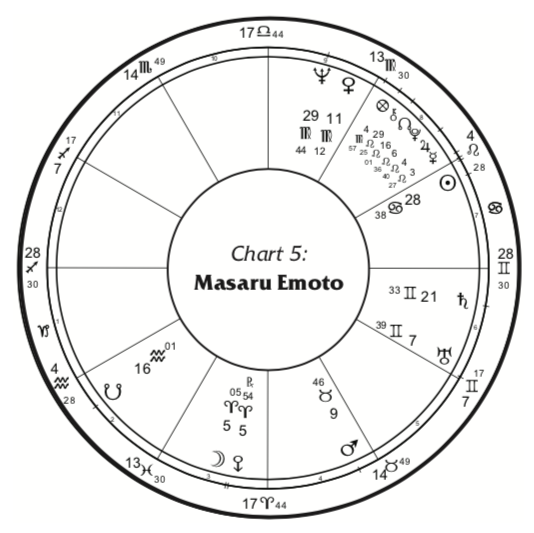 Then there is the recently deceased Masaru Emoto,
the disruptive scientist of water, who famously demonstrated that the
structure of the crystals that are formed from a water sample as it
freezes depends on the quality of positive attention that has been paid
to the sample. Classical music helps, as does a positive word written on
paper — defamatory words having the opposite effect. One can only imagine
what these same words do to individual children who hear them directed at
themselves on the typical playground.
Then there is the recently deceased Masaru Emoto,
the disruptive scientist of water, who famously demonstrated that the
structure of the crystals that are formed from a water sample as it
freezes depends on the quality of positive attention that has been paid
to the sample. Classical music helps, as does a positive word written on
paper — defamatory words having the opposite effect. One can only imagine
what these same words do to individual children who hear them directed at
themselves on the typical playground.
Emoto was born on July 22, 1943, with a partile Moon–Eris conjunction. Eris is in a close trine to his triple conjunction of Mercury, Jupiter, and Pluto, making a partile trine to the Jupiter/Pluto midpoint. Eris is also sextile Uranus within less than 2 degrees, opposite Neptune (out of sign), and closely bi-quintile Chiron. Incidentally, a number of these scientists have close Eris–Moon aspects — as does Einstein (a partile square).
A Closer Look at Einstein
 For Albert Einstein, modern exemplar of
paradigm shifter, we also find a prominent Eris. There are two interesting
things about the Eris placement in Einstein’s chart. One is its
elevated position in the 10th house, close to the Midheaven (MC); the
other is its partile square to the Moon, his chart ruler. The square is
the only close major aspect that Eris makes to any personal planet,
although it is semi-sextile Venus, quintile Pluto, and septile Chiron.
This emphasis on Einstein’s Moon might at first glance seem
startling in the chart of the greatest physicist of the 20th century,
when we might have expected Mercury, Uranus, or a combination of Jupiter
and Uranus to be more prominent.
For Albert Einstein, modern exemplar of
paradigm shifter, we also find a prominent Eris. There are two interesting
things about the Eris placement in Einstein’s chart. One is its
elevated position in the 10th house, close to the Midheaven (MC); the
other is its partile square to the Moon, his chart ruler. The square is
the only close major aspect that Eris makes to any personal planet,
although it is semi-sextile Venus, quintile Pluto, and septile Chiron.
This emphasis on Einstein’s Moon might at first glance seem
startling in the chart of the greatest physicist of the 20th century,
when we might have expected Mercury, Uranus, or a combination of Jupiter
and Uranus to be more prominent.
The Eris placement in Einstein’s chart at the MC reveals someone with the personal strength to pursue his own thinking, even as an outsider to the world of universities and the scientific establishment of his day. His greatest discoveries were made virtually alone, published in scientific journals while he worked as an examiner in the Swiss patent office. He was the quintessential maverick, an outsider with a complex relationship to authority, which gives us further insight into the nature of the Eris archetype as symbolizing a solitary person who takes a strong and uniquely individual stand.
And what are we to make of Einstein’s Eris–Moon emphasis? Looking at his life, we can see that his strong Moon — singular in the second quadrant of the chart, trine Venus, and empowered by the close Eris square — properly represents a man who adored women, with the love of home and family being an important part of his makeup. Einstein’s biography shows that he was attractive to women and was never without a female companion from the age of 16 until just a few years before his death at 76.5
Einstein was also a confirmed pacifist all his life, showing this softer side of his character. His legacy for today’s world goes far beyond his tremendous contribution to physics and mathematics and includes many pithy sayings, among them: “Imagination is more important than knowledge” and “You cannot simultaneously prevent and prepare for war.” His explorations into the laws of physics were also unusual, involving nonverbal methods, such as his famous thought-experiments that included chasing a beam of light. All this fits together nicely with his strong Moon, symbolizing an intelligence that comes in from left field, rather than following the shining and dominant Apollo beam of logic and rationality. Einstein’s intuitive and nonverbal method of visualizing (Moon in Sagittarius) replaced a more conventionally academic use of logic, deriving new descriptions of the physical universe that could in the end be composed into mathematical ones.
 Einstein’s Moon is one focus here because Eris
makes such a close square to it. In my research, I have found over and
over again that Eris in combination with natal planets greatly expands
their impact. Another example would be C. G. Jung, who has Eris in a
partile trine to Mercury, within four arc minutes, among other strong
aspects (chart not shown); Jung was a prolific lecturer and author, in
four languages, as well as a shifter of paradigms within the field of
psychology.
Einstein’s Moon is one focus here because Eris
makes such a close square to it. In my research, I have found over and
over again that Eris in combination with natal planets greatly expands
their impact. Another example would be C. G. Jung, who has Eris in a
partile trine to Mercury, within four arc minutes, among other strong
aspects (chart not shown); Jung was a prolific lecturer and author, in
four languages, as well as a shifter of paradigms within the field of
psychology.
The timing of the publication of Einstein’s original insights that secured his reputation represents, as it did with Newton, another example of the remarkable impact of transiting Eris in the lives of these paradigm shifters. Natally, Eris was located early in Einstein’s 10th house, so that two decades later, its transit over Einstein’s 10th-house Sun accompanied the crucial beginnings of his worldwide renown. Eris was within 2° of a conjunction with the Sun from 1899 to 1909, with twelve exact hits beginning in June 1901 and ending with a conjunction in February 1905, followed by a station direct in mid December, the latter taking place within less than one minute of arc to his natal Sun. These are the very years when Einstein was formulating his breakthrough theories. Letters from 1899 reveal the beginning of the thought process that would lead to the special theory of relativity.6 The year 1905, when Eris was directly on his Sun, is referred to as his annus mirabilis (“miracle year”) in which he published a bumper crop of articles that eventually reconstituted the foundations of modern physics. There were five groundbreaking papers on subjects including the photoelectric effect, Brownian motion, special relativity, and the equivalence of mass and energy; from these he received international attention and the respect of the academic world — and eventually the Nobel Prize.7 By 1909, he had quit the patent office and was appointed to a professorship at the University of Bern.
Henry David Thoreau
Paradigm shifters do not have to be scientists. For an example, let’s consider the life and astrology of Henry David Thoreau (chart not shown). He was the famous iconoclast who initiated the back-to-nature movement that became a countercultural way of life in the 1960s. Born on July 12, 1817, he has Eris at 13° Aquarius aspecting other outer planets in Sagittarius: quintile Jupiter, sextile Uranus, and septile Neptune, all within about a degree. His Eris is also semi-square Pluto in Pisces and sesquiquadrate his Mercury in the first degree of Cancer.
When Thoreau started his two-year escape from modern civilization at Walden Pond, on July 4, 1845, and began writing his classic, Walden, transiting Eris at 0° Pisces was in a tight trine to his natal Mercury at 1° Cancer, with transiting Uranus in Aries sextile his natal Eris. Pluto, also in Aries, made a close quintile (only 6 arc minutes from exact) to his natal Eris, while the transiting Cancer New Moon of that day was quincunx his natal Eris to the degree. Nine years later, in 1854, with Eris stationing on his Saturn in Pisces, the work was finally published.
After his two years in the woods, in February 1848, Thoreau gave several lectures on civil disobedience that were later published as Resistance to Civil Government. Eris was still at 0° Pisces, closely trine his natal Mercury and conjunct transiting Neptune within one degree.
Astrologers as Paradigm Shifters
In summing up the correlation of a strong Eris with paradigm shifters, we will also note that astrologers in these modern times are paradigm shifters as well — mavericks going against the grain of their culture in order to enable an important cosmological transition away from the strictly logical and straight-line approach that, in the final analysis, stems from the rigidity of 19th-century thinking. To demonstrate with a fine example, let’s take a look at the chart of Dane Rudhyar, the pioneering theorist who shook up the existing astrological status quo by establishing a new wave of humanistic astrology.
 According to his own rectified birth time,
Eris is conjunct his North Node within one degree, tightly sesquiquadrate
Saturn, closely trine Uranus (associated with astrology), and also in a
close square to the Jupiter/Neptune midpoint at 20°32' Gemini —
highlighting the triple conjunction of Pluto, Mars, and Neptune in that
sign. The inclusion of the Jupiter/Neptune midpoint in this Eris
configuration pulls these planets even closer together in his chart. This
is fitting symbolism for one who took the spiritual side of both music
and astrology to a new high-water mark with his many, philosophically
oriented books and articles.
According to his own rectified birth time,
Eris is conjunct his North Node within one degree, tightly sesquiquadrate
Saturn, closely trine Uranus (associated with astrology), and also in a
close square to the Jupiter/Neptune midpoint at 20°32' Gemini —
highlighting the triple conjunction of Pluto, Mars, and Neptune in that
sign. The inclusion of the Jupiter/Neptune midpoint in this Eris
configuration pulls these planets even closer together in his chart. This
is fitting symbolism for one who took the spiritual side of both music
and astrology to a new high-water mark with his many, philosophically
oriented books and articles.
Let’s consider the chart (not shown) of another iconic astrologer of his generation: Marc Edmund Jones, born on October 1, 1888. Eris at 18° Pisces closely aspects Uranus in Libra — in this case, by a quincunx within one degree. Eris is also quincunx a tight Moon–Saturn conjunction in Leo, forming a yod, and is precisely sesquiquadrate Mercury in early Scorpio (which is conjunct Venus), square Mars in Sagittarius, and quintile Neptune in Gemini.
Alan Leo was another originator within the astrological paradigm. Born on August 7, 1860, his Eris at 7° Pisces squares Uranus in Gemini and also aspects Mars, Jupiter, and Pluto (chart not shown).
Barbara Marx Hubbard
 One final example of a paradigm shifter in a cultural
setting involves a well-known exemplar of revolutionary thought and
action. Barbara Marx Hubbard is a dynamic spokesperson for the inception
of the Aquarian Age, an innovator among feminist voices, and a champion
of an onrushing cultural paradigm shift; she foresees a changing of the
guard in Western social evolution. In 1984, she was a candidate for
vice-president of the United States. She is considered a futurist and
coined the term “the birthing of humanity.” Her mission
includes what could be termed a transfer of power away from the
prevailing cosmology and the stultifying weight of the consensus thinking
that currently runs our Earth, toward a view that better serves its
people. This idea represents a growth in the understanding of — and a
reliance on — Spirit as a guiding principle. The Amazon website sums up
her contribution in this way:
One final example of a paradigm shifter in a cultural
setting involves a well-known exemplar of revolutionary thought and
action. Barbara Marx Hubbard is a dynamic spokesperson for the inception
of the Aquarian Age, an innovator among feminist voices, and a champion
of an onrushing cultural paradigm shift; she foresees a changing of the
guard in Western social evolution. In 1984, she was a candidate for
vice-president of the United States. She is considered a futurist and
coined the term “the birthing of humanity.” Her mission
includes what could be termed a transfer of power away from the
prevailing cosmology and the stultifying weight of the consensus thinking
that currently runs our Earth, toward a view that better serves its
people. This idea represents a growth in the understanding of — and a
reliance on — Spirit as a guiding principle. The Amazon website sums up
her contribution in this way:
A world-renowned visionary futurist, evolutionary educator and inspiring speaker, Barbara is the author of six acclaimed books that communicate the new worldview of conscious evolution. She is the co-founder and chair of the Foundation for Conscious Evolution, and additionally co-founded many progressive organizations, including The Association for Global New Thought, as well as The World Future Society.8
An anecdote recalls her first steps away from the cultural conditioning that surrounded her youth, in terms that echo the emerging Eris archetype: “When the United States dropped the atomic bomb on Hiroshima in 1945, Hubbard as a teenager began questioning the purpose of our power. From that point forward, she approached her education, her relationships, and her life’s choices in the context of two questions: ‘What is the purpose of humanity’s power?’ and ‘What is my purpose?’”9
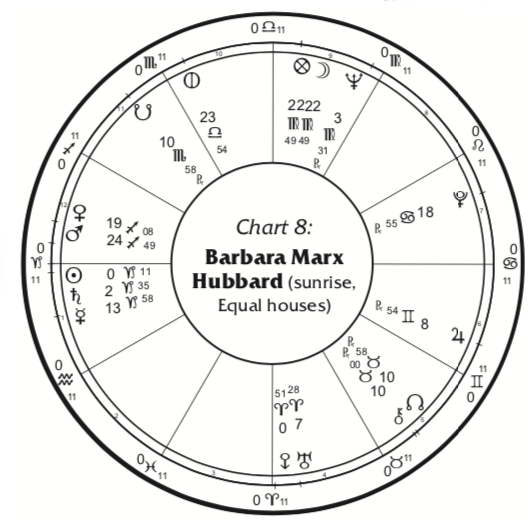 Since
her birth time is unknown, we are using the Equal House system based on
her Sun degree at the Ascendant, as is usual for sunrise charts. Activist
and paradigm shifter that she is, it’s fitting that we find Eris in
partile square to her Sun degree. Additionally, her Saturn–Uranus natal
square, which characterizes her Aquarian lack of sympathy for an outmoded
status quo, is greatly emphasized by the presence of Eris conjunct Uranus
and in a close square to Saturn. Eris is also parallel to Mercury, the
signature of a prolific speaker and writer.
Since
her birth time is unknown, we are using the Equal House system based on
her Sun degree at the Ascendant, as is usual for sunrise charts. Activist
and paradigm shifter that she is, it’s fitting that we find Eris in
partile square to her Sun degree. Additionally, her Saturn–Uranus natal
square, which characterizes her Aquarian lack of sympathy for an outmoded
status quo, is greatly emphasized by the presence of Eris conjunct Uranus
and in a close square to Saturn. Eris is also parallel to Mercury, the
signature of a prolific speaker and writer.
The prominent Saturn being empowered and countered by Eris indicates that, while Hubbard comes from a relatively stable point of view that believes in tradition, she would still like to tear down and replace the existing establishment from within. She stated in 2012:
It has become obvious that a creative minority of humanity is undergoing a profound inner mutation or transformation. Evolutionary ideas are not only serving to make sense of this change, but also acting to catalyze the potential within us to transform.10
As revealed by a great deal of evidence amassed over the past several years from both clients and notable horoscopes — and as demonstrated by these charts — there is a powerful archetype emerging in Western astrological practice: Eris as Spiritual Warrior. It is my belief is that each person’s soul-level intention is thereby revealed. In these fraught times, it has become a vital necessity that each one of us find the way, as Jung did, to make our own voices heard as a counter to the rising tide of materialism and purely linear thinking that threatens to sink our collective ship of state. This is the reason that I find Eris to be a planetary archetype whose advent is so very timely and particularly appropriate, as we struggle to correct our current 21st-century global situation.
Chart data and sources:
(in alphabetical order)
Nicolaus Copernicus, February 28, 1473 (Gregorian,
“New Style”); 5:13 p.m. LMT; Torun, Poland; AA:
Constellations 1977 quotes J. Scperkowicz, Nicolaus
Copernicus,” data from astrologers present at his
birth.”
Albert Einstein, March 14, 1879; 11:30 a.m. LMT; Ulm,
Germany; AA: birth certificate in hand from Einstein Archive.
Masaru Emoto, July 22, 1943; 4:50 p.m. JST; Yokohama,
Japan; A: from his older sister to Vaughn Paul Manley, writing in
TMA, Feb./March 2006.
Galileo Galilei, February 26, 1564 (Julian,
“Old Style”); 3:41 p.m. LMT; Pisa, Italy; A: Nick Kollerstrom
photocopied charts drawn by Galileo from the Florence library, but there
are inconsistencies.
Werner Heisenberg, December 5, 1901; 4:45 p.m. CET;
Würzburg, Germany; AA: birth certificate in hand, Steinbrecher.
Barbara Marx Hubbard, December 22, 1929; time
unknown (sunrise EST used); New York, NY, USA; X: date without a time;
date and location from Internet sources.
Marc Edmund Jones, October 1, 1888; 8:37 a.m. CST;
St. Louis, MO, USA; A: given by him in his book, Sabian
Symbols.
Carl Gustav Jung, July 26, 1875; 7:29 p.m. LMT;
Kesswil, Switzerland; C: rectified from approximate time, to place the
Sun on the Descendant.
Johannes Kepler, January 6, 1572 (N.S.); 2:37 p.m.
LMT; Weil der Stadt, Germany; B: from his book, Harmonics, Book
IV.
Thomas S. Kuhn, July 18, 1922; time unknown (sunrise
CDT used); Cincinnati, OH, USA; X: date and location from Internet
sources.
Alan Leo, August 7, 1860; 5:49 a.m. GMT; Westminster,
England; B: from his book, Esoteric Astrology.
Isaac Newton, January 4, 1643 (N.S.); 1:38 a.m. LMT;
Woolsthorpe Manor, England; C: Arthur Blackwell quotes F. Manuel, A
Portrait of Isaac Newton (1968), “born an hour or two after
midnight” (December 25, 1642 O.S.); Ebertin gave “between
1:00 and 2:00 a.m.,” rectified by Blackwell to 1:38 a.m.
Dane Rudhyar, March 23, 1895; 12:42 a.m. LMT; Paris,
France; A: Accurate data from Rudhyar himself confirming the Ascendant
and Midheaven degrees, in An Astrological Mandala, Vintage Books,
1974, p. 371.
Henry David Thoreau, July 12, 1817; 2:00 p.m. LMT;
Concord, MA, USA; DD: time is speculative; Starkman rectified it to
9:48:56 LMT.
Notes and References:
All charts use Placidus houses and the True Node, except where noted.
The charts were prepared using the author’s TimePassages astrology software,
available for iPhone/Android, as well as Windows and macOS.
1.
www.goodreads.com/quotes/47155-to-punish-me-for-my-contempt-for-authority-fate-made
2. The aspect orbs that I tend to use are a little wide, though not
atypical, and vary somewhat with the context of the chart itself. They
range from 8–10° for the conjunction/opposition to 1.5° for the septile.
For aspects involving the Sun or Moon, the orbs can be up to 50%
wider.
3. André Goddu, Copernicus and the Aristotelian Tradition:
Education, Reading, and Philosophy in Copernicus’s Path to
Heliocentrism, Brill, Leiden/Boston, 2010, p. 351.
4. Richard Tarnas, Cosmos and Psyche, Viking, 2006, p. 297.
The year of 1927 was the year in which “the pace of discovery in
theoretical physics was perhaps greater than in any other year in the
history of science.”
5. Albrecht Fölsing, Albert Einstein: A Biography, trans.
Ewald Osers, Viking, 1997.
6. Ibid., p. 62.
7. Einstein’s Miraculous Year: Five Papers that Changed the
Face of Physics, edited by John Stachel, with the assistance of
Trevor Lipscombe, Alice Calaprice, and Sam Elworthy; and with a foreword
by Roger Penrose, Princeton University Press, 1998.
8. www.amazon.com/Barbara-Marx-Hubbard/e/B001K7V9CA/
9. From a 1993 School of Metaphysics Thresholds interview,
“The Age of Co-Creation,”
www.som.org/3library/interviews/hubbard.htm
10. Quoted in the description of an event called Conscious
Evolutionaries Chicago,
www.meetup.com/Chicago-Cross-Cultural-Meetup-Group/events/76679082/
Images:
Nicolaus Copernicus: Toruń Regional Museum / Public domain
Isaac Newton: After Godfrey Kneller / Public domain
Werner Heisenberg: Bundesarchiv, Bild 183-R57262 / Unknown author /
CC-BY-SA 3.0 / CC BY-SA 3.0 DE
(https://creativecommons.org/licenses/by-sa/3.0/de/deed.en)
Albert Einstein 1904: Lucien Chavan [1] (1868 - 1942), a friend of
Einsteinʹs when he was living in Berne. / Public domain
Barbara Marx Hubbard: Norman Kremer / CC BY-SA
(https://creativecommons.org/licenses/by-sa/1.0)
First published in: The Mountain Astrologer, Apr/May 2015.
Author:
 Henry Seltzer has been an astrologer for
over 30 years and a speaker at conferences for the past several. His
publications include The Tenth Planet: Revelations from the
Astrological Eris, and TimePassages, astrology software for
iPhone/Android, and for desktop platforms, the latter of which comes
complete with natal Eris interpretations. For software, and monthly
content, visit the AstroGraph site at: www.astrograph.com.
Henry maintains an active astrological counseling practice in Santa Cruz,
CA.
Henry Seltzer has been an astrologer for
over 30 years and a speaker at conferences for the past several. His
publications include The Tenth Planet: Revelations from the
Astrological Eris, and TimePassages, astrology software for
iPhone/Android, and for desktop platforms, the latter of which comes
complete with natal Eris interpretations. For software, and monthly
content, visit the AstroGraph site at: www.astrograph.com.
Henry maintains an active astrological counseling practice in Santa Cruz,
CA.